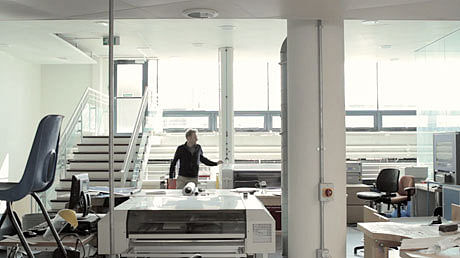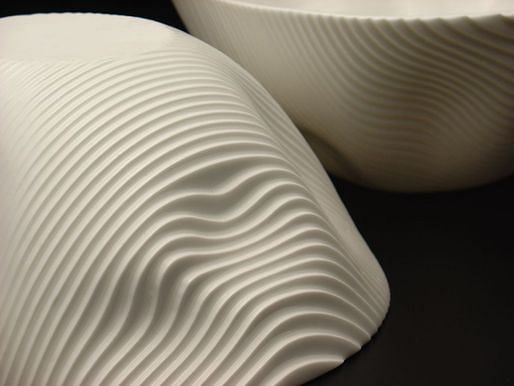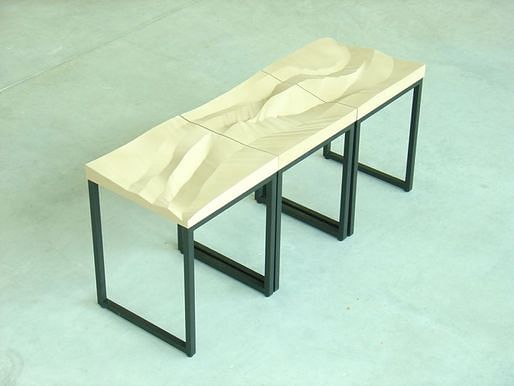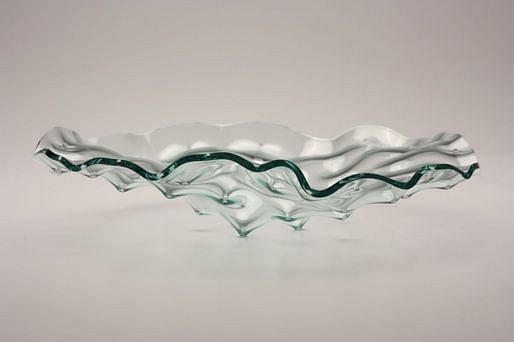
Jan '12 - Aug '13
The second interview that I'll be sharing from my research into craftsmanship and digital fabrication took place with Tavs Jøgensen, a permanent research fellow in the Autonomatic Group at University College Falmouth and visiting tutor for the Royal College of Art's Ceramics & Glass course. Tavs and I have been communicating sporadically for almost a year now and I'm humbled to be given the chance to expose his work to an audience that is likely unaware of what he and his colleagues in the Autonomatic Group are doing.
Tavs and I were put in touch with one another by John Marshall, a faculty member here at the University of Michigan that I was lucky enough to discuss my academic interests with early in the fall 2011 semester. John is incredibly knowledgeable of any research (past or present) dealing with "digital making" and quickly pointed me towards the Autonomatic Group as a body of work I needed to be familiar with. Much to my surprise a week later I received an email from John introducing me to Tavs.
After a number of email exchanges I finally got to meet Tavs in early 2012 when he came to the US for the Tool at Hand exhibit at the Milwaukee Art Museum and spent some time in Ann Arbor. Towards the end of his visit we sat down for a 'formal' discussion, delving a bit deeper into topics that we had touched upon in earlier conversations. I'm a big fan of Tavs's work and the conversation we were able to have about it. Its not because we're investigating similar glass forming techniques, but rather because of the serious consideration he has given to how he engages the collection of digital tools he's incorporated into his practice. Exposure to Tavs's work and the research going on in the crafts arts as a whole was an eye-opening experience.
I've included a fantastic video at the bottom of the page that goes into the specifics of the Glass One Liner bowls that is well worth taking the time to watch and pay attention to.

Tavs at play in the Autonomatic Group's research space at University College Falmouth.
Image from the UK Crafts Council
Aaron Willette: Neither of us have a formal computation/engineering background: I’m coming at digital fabrication from architecture and you’re coming at it from the craft arts. So how did you first get into the whole digital side of things?
Tavs Jørgensen: When I was sixteen I had signed up for an apprenticeship to train as a potter. At the time my friends had their Commodores and I made a very clear decision that I had no interest in that. I was an early rejectionist of sorts. I went through my apprenticeship, qualified as a potter and worked as a potter for a number of years. Then I started to move more in the design direction with ceramics. Going from a craft sphere to a design sphere it was the new possibilities of drawing and making things that got me interested in the digital.
Then an opportunity turned up when a center opened in Stokes-On-Trent called The Hothouse Centre of Ceramic Design. They were inviting people to experience and use these new tools, and I was selected for that having done no computer work whatsoever. We learned a very early modeling package, they had a CNC mill and there were also rumors about rapid prototyping and that sort of thing. Coming from quite a strong opposition to digital technology I became very interested in it but always maintained a critical view of it given that background. After doing the course at Hothouse I was invited to do a couple other projects at other universities that were wondering about these technologies and what their implications for designers are.
AW: Coming from a traditional craft arts background, what's been the response from the rest of the field to individuals such as yourself who are bringing these technologies into the studio? Have they been receptive?
TJ: “Craft” means a slightly different thing in the UK and elsewhere actually. The craft sphere in the UK is hard to define but it occupies a particular space between fine art and design. The digital technology has been around for probably about 15 years now, and you'd think we’re beyond that conversation. We know it's got value and can have a very appropriate role in what we consider craft practice. But even today you find people that say, “Well, it’s all about pressing a button and then it does it for you.”
In craft practice in the UK and Scandinavia, there’s a strong link to process and that part of an object's value is embedded in the process of its creation. There’s a provenance in someone throwing a pot or weaving fabric. And maybe that provenance is more difficult for some people to deal with when you throw computational creativity into the mix. All of a sudden there are questions of what role it plays and where skill is embedded in those processes. We’re so familiar with throwing pots that we can say, “That’s a good pot,” or “That’s a bad pot.” Where are the good and bad qualities in terms of the digital design and fabrication processes we are developing? I think particularly in the crafts those can be difficult to really identify and that’s why I think people aren't comfortable with it.
AW: No, I definitely think that’s something architecture is also dealing with.
TJ: Really?
AW: As far as how one starts to evaluate the work and what the terms for understanding it are. Architecturally, what’s brought to the foreground by computation doesn't always fit into the traditional modes of evaluation regarding “good” versus “bad”. Its something we’re still trying to flesh out and is one of the reasons why I was first drawn to the craft arts looking for parallels. It seems like this is something that the crafts have thought about a bit more already.
TJ: One of the things that I have tried to do in a couple of projects is to make them more about getting back to a hand quality. With the glass bowl and the seat it’s just about recording the movements of the hand just as you would when throwing a pot or hand sketching. The technology is purely there as a recording device. The less influence on the aesthetics that it can have, the better.
Digital technology can be a much more transparent recording device than many of the analog recording devices like pen and paper. You’re still working on a plane and you’re still engaging/disengaging physicality, but it can be even more accurate. I suppose that’s one approach to bringing potential value and a way of measuring and using technology. Its not about technology at all, it’s just about an intention with the hands.

Contour Range, by Tavs Jørgensen.
AW: So in those instances you’re arguing that we evaluate these new objects, “new” only in how they’re generated, on the traditional terms of crafts?
TJ: Then the technology is purely a facilitator in terms of communication. That’s one approach that I've certainly taken and I hope that’s what comes through in the object. Like a high-definition screen it delivers incredibly clear vision, but it’s not necessarily the sharpness that you should look at. It’s the content. I suppose some would argue that the facility to actually do that and to deliver a mirage in such resolution itself has an effect as it’s not reality and yet it’s still recorded.
AW: With that I think you start to get more into topics such as McLuhan's theories on media and the like. It quickly becomes an endless rabbit hole that keeps going and going. By the time the conversation is done, you've completely moved away from the craft object conversation.
TJ: It’s a very good observation because there are some fundamentally good things about craft practice. The engagement with an object, the engagement with materials and process. There is a very close link between that object and its maker, consumer and user.
AW: I think that’s one reason why architects are so attracted to some of the digital tools. They allows us to make that connection even though architecture is largely removed from the act of making. Traditionally architects produce drawings that are handed off to a second, and then a third party handles the act of making. For a lot of people, myself included, digital fabrication provides a means to engage materials and understand the value of making. That’s why I find value in looking at contemporary crafts. If that’s a model we’re striving for, we need to understand what's already been done towards understanding these modes of operation.

Motion Seats, by Tavs Jørgensen
TJ: Architecture is such a very big field with so many approaches.
AW: And because it is such a big field people like myself are able to operate within it. It allows for individuals who are interested in coding and digital fabrication to still participate in the profession in a meaningful way.
TJ: Architects seem to be the most visible in terms of their use of digital technologies. Digital fabrication, parametrics and those things seem to be quite evident in architecture as a movement. I know there’s parametric modeling and digital fabrication in many other fields, but it’s obvious in architecture's aesthetics more than elsewhere.
AW: So onto some shop talk... what’s your favorite tool? You've covered a wide range of things in your work from digitized input to CNC milling and everything else. Could you even say that you have one?
TJ: No, I probably don’t in my current practice. I don’t love my digital tools as much as I used to love my manual tools.
AW: I have a micrometer that belonged to my grandfather that I love to use. There’s the tactility of the object along with a sense of nostalgia that feeds into the experience. When writing a script or using the CNC mill I don’t think there’s that same level of attachment. With digital tools it feels a lot easier to let go and move on.
TJ: There really is a different relationship with the tool. At times I'm sick of the sight of Rhino or Grasshopper, and I'm sure you've felt the same way. It’s a bit like email: it’s a fantastic tool for communication but it can be this kind of incredible weight. Rhino has all these possibilities that are always there at your fingertips but there’s never enough time to explore them all and do them all well enough. Recently my computer broke and I had to leave it at the Apple Store for about three days and I felt there was this huge weight off my shoulders. There was no obligation for me to do anything for those couple of days. I don’t think I've ever felt like that with manual tools.
AW: I wonder how much that lack of attachment has allowed the progress that's been made with these tools to happen in the short amount of time that they have. It’s so easy to let go of one project and move on to the next. I don’t know if it allows us to be more objective regarding the tools themselves or not, but we're able to step away from them, evaluate their success and adjust accordingly. Not having those attachments allows for the iterative process to be introduced into the tooling itself.
TJ: On the other hand I have made the worst possible things with digital tools that I have ever, ever made. Shockingly bad. And why? Possibly because of that detachment. When you are drawing in virtual space things are smooth and lovely, and you experience them in a very specific way. Then when it comes time to make it you realize that it’s very different from what you thought it was.
AW: While I fully support Malcolm McCullough's writing and people who are involved in purely digital production, personally it doesn't carry the same weight as when you’re forced to make the digital physical. There’s some value in the object itself and the space it takes up. The primacy of its physicality can’t be denied.
TJ: I don’t know how you can do scripting for such periods of time. I am not sure I could keep my motivation up. You could be looking at weeks, if not months, before you actually get the pin to operate in a pin kiln and you get a sheet of glass out according to the script.
AW: That can be the more frustrating parts of how I work. I typically want to get right into the making and forget about writing scripts. Just play around. But with my work I can't have one without the other as there is leg work that needs to get done to get the logics and frameworks up and running first. I work through that because I know what comes after it: the making.
What’s next on your horizon? What’s gathering your interest as far as the next “thing” to play with?
TJ: Reconfigurable tooling is actually very interesting for me as a kind of technique. Particularly because people have had a go at it for years - it’s kind of unobtainable and no one has really cracked it. Also maybe starting to look at materials and work back from there, rather than working from a principle and applying it to a material. I think looking at material qualities and exploring those properties through fabrication can be done in really innovative ways. It’s more the formative elements of digital manufacturing that interest me because you need to look at material properties to get them working. There’s so much more to explore in terms of actually looking at material qualities and using them.

Slumped glass form & custom reconfigurable pin tooling.
AW: Coming from the architectural side of the conversation, there’s definitely a similar interest to tie these tools back to the more traditional material experimentation and logics of architecture. The work of Achim Menges, the head of the Institute for Computational Design in Stuttgart, has been able to integrate material studies with computation to look at how we can manipulate the cells of wood to achieve certain effects, computing that alongside standard topics like formal complexity.
TJ: Material properties is a really interesting field to work back from. The digital manufacturing methods we've got now use a technology-down approach. As I see it, we've got a certain technology and its become a question of what we can mill rather than starting from a material and asking how can we manipulate that in a way that’s specific to the properties of that material.
Your opening line was that neither of us come from a computational background. There are practitioners in this field who have been trained formally in computer science, and that leads to questions of what role practitioners like you and I have in this emerging space. That the material knowledge that we bring to the table plays a role in answering that.

Pin Bowls, by Tavs Jørgensen.
AW: Coming from a design background it’s also very important that we have the ability to evaluate and curate. We can produce something and, if we’re honest, can say, “That’s good, that’s not good.” You may have the most amazing computer scientist in the world writing a program for something but if they don’t have that evaluative ability, then for what we’re doing there’s little point to it. I'd like to think individuals such as ourselves add value by how we use those sensibilities to our advantage.
TJ: That’s a very good point, it brings meaning into things.
AW: Part of my interest in looking at the craft arts specifically is that there’s the tradition of understanding the larger cultural implications of both process and the materials themselves. Seeing a beautifully scripted object that has no value beyond the fact that it’s a beautifully scripted object is incredibly frustrating. Anything someone produces is going to be biased based on how they interpret culture, but at this point in time there needs to be meaning beyond the novelty of the computer. I wonder if we can use digital fabrication as a way to bring some sort of cultural understanding into architecture. I don't feel the digital side of things has really started to touch on these other aspects of making. It’s a challenge a lot of us are probably grappling with as we use these tools and there aren't any resolved answers. It’d be a lot easier if there was.
TJ: (Laughs) Absolutely.
The artifact has throughout history held meanings and it has to be able to find new meanings. Our museums are full of artifacts with meanings and it is almost impossible to find cultures that don’t assign meaning to artifact products. It’s very important to produce artifacts and products because it’s just an inherent part of culture. That’s why digital tools, probably more than anything, enable us to make again. Particularly in the Western world where we so much is being outsource. We are finding ourselves through what we've bought rather that what we've made. I think there is just an opportunity to make again and produce things of meaning. That may be entirely naive, but there is meaning that becomes embedded in the object.
Unless otherwise stated, all images courtesy of Tavs Jørgensen.
An in-the-trenches view of digital fabrication, academic research, post-hardcore music and whiskey. Not necessarily in that order and often in combination.
1 Comment
TJ: No, I probably don’t in my current practice. I don’t love my digital tools as much as I used to love my manual tools.
I wonder if this is something that will have to change for digital fabrication to take off or have the same sort of folk, connotations as hand-crafted etc.. It seems digital fabrication could lead to a divorcing of nostalgia for hand-tools or reinforcing it by serving as he puts it earlier "recording device"..
Block this user
Are you sure you want to block this user and hide all related comments throughout the site?
Archinect
This is your first comment on Archinect. Your comment will be visible once approved.